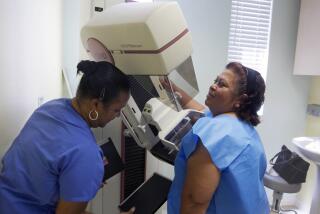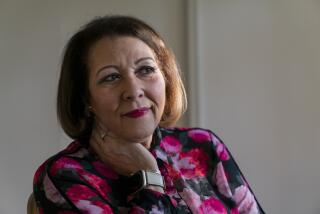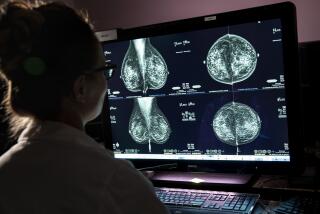Ultrasound as a breast cancer test is becoming more accepted
Susan Beane, a 45-year-old mother of two, had undergone regular mammograms for five years. Each time, she got a clean bill of health. But nine months after her most recent routine screening, she felt a lump.
A follow-up mammogram failed to produce a picture of the growth. It wasn’t until Beane underwent an ultrasound that the radiologist found the 1.6-centimeter tumor that was eventually determined to be cancer. The disease had spread to at least one of her lymph nodes. In February, Beane had a double mastectomy.
The Castle Rock, Colo., woman said she believes that ultrasound should be part of a routine screening for women who, like her, have dense breast tissue, a category that includes about half of all women undergoing breast screening. Dense tissue can mask tumors on mammograms.
“If I’d had an ultrasound during my routine screening nine months earlier, then I would have been diagnosed sooner. The cancer probably wouldn’t have spread. I wouldn’t have needed chemotherapy and probably could have saved my breasts,” Beane says.
Many doctors increasingly agree with that assessment. Across the country, more physicians are ordering ultrasound in addition to mammography for women whose breast tissue is dense. Currently, standard practice calls for diagnostic (as opposed to screening) ultrasound only when a mammogram or clinical breast exam reveals something suspicious.
A panel report issued last week from the Institute of Medicine and National Research Council of the National Academies supported the need to do more to detect breast cancer. The panel concurred that mammography, though still useful, wasn’t always enough and that health practitioners needed to investigate other complementary screening methods.
Using ultrasound as a screening tool doubles the rate of breast cancer detection in women with dense breasts, said Wendie Berg, a Baltimore radiologist and a principal investigator for a large-scale nationwide study to further examine the benefits and efficacy of ultrasound screening.
“Mammography depicts about three to five cancers per 1,000 women,” Berg said. “In women with dense breasts, studies have shown, ultrasound depicts another three cancers per 1,000 women. Significantly, the cancers found only on ultrasound are almost all small invasive cancers that have not yet spread to the lymph nodes and therefore have good prognoses.”
Other doctors say it’s too early to make ultrasound routine for screening purposes. They say that the data to date don’t justify it, that the method has a higher rate of false positives -- areas that look suspicious but that are shown by biopsies to be benign -- and that the cost and availability of good screeners make widespread screening impractical.
Daniel Kopans, director of breast imaging at Massachusetts General Hospital and professor of radiology at Harvard Medical School, is an outspoken critic. There is no proof that the test saves lives, he said in a recent interview.
And as he wrote in an opinion paper published in the November 2003 issue of the American Journal of Roentgenology: “We need more supportive evidence before we screen and potentially needlessly scare women. We need to be certain the test will do more good than harm.”
He’s especially concerned about the rate of false positives. “These are unavoidable and result in anxiety, recall of patients for additional evaluations, biopsies, useless and unnecessary treatment and inconvenience,” his paper said.
Depending on the center, a woman runs a 2% to 6% chance of undergoing an unnecessary aspiration or biopsy as a result of screening ultrasound, Berg said. (In a 2002 study, the false-positive rate of biopsy was 2.4%.) By comparison, the false positive biopsy rate following mammography is 1% to 2%, Kopans said.
Cost and resources pose other barriers to routine ultrasound screening. Insurance companies typically don’t cover the $150 to $450 test. And the reliability of the tests depends on the person reading the results. “Not enough centers have the equipment or the expertise to do these studies well,” Berg said.
But despite the drawbacks, some experts say ultrasound is a useful tool that -- based on studies to date -- reveals significantly more cancers than does mammography alone in women with dense breasts. These cancers tend to be small invasive cancers in an early stage.
In the 2002 study, conducted by New York radiologist Thomas Kolb and published in the journal Radiology, 11,130 women who had no signs of breast cancer each had a mammogram followed by a clinical examination. Women who had denser (as opposed to fatty) breasts (49%) also underwent an ultrasound. Overall, cancer was found in 221 women.
The study found that mammography detected 98% of cancers in women with fatty breast tissue, but only 48% of the cancers in women with the densest breasts. Ultrasound added to the mammography screening revealed another 46% in that group, or 94% of the cancers. (The clinical exam found the remainder.)
Significantly, the majority of cancers depicted by ultrasound alone were smaller than 1 centimeter, and 90% were node negative, meaning Stage 1 cancers with good prognoses. Other single-center studies have supported similar findings, Berg said.
In light of such research, the American Cancer Society has revised its breast cancer screening guidelines for the first time since 1997. The new guidelines acknowledge a role for ultrasound in screening and recommend that women at increased risk -- those with a family history, genetic tendency or past breast cancer -- talk to their doctors about having additional tests, such as breast ultrasound or MRI, along with their mammograms. The guidelines stop short, however, of recommending breast screening ultrasounds for women with dense breasts who are not at risk.
Doctors rate breast density according to four categories, from 1 (fatty) to 4 (extremely dense). Younger women have denser breasts than older women. According to Berg, 62% of women in their 30s have dense breasts, 56% of women in their 40s, 37% of women in their 50s, and 27% of women in their 60s. The only way to know your breast density is by mammogram.
Although a family history of breast cancer puts a woman at higher risk of developing breast cancer, 80% of women who develop breast cancer have no history.
To Elizabeth Pusey, a radiologist in Newport Beach, the studies and her experience suggest it’s prudent to perform ultrasound along with mammography on all women with dense breasts. “When you’re in private practice, you have a little more leeway. You have the freedom to do for patients what you would want done for yourself,” she said.
Five years ago, Pusey started doing ultrasound screening on women with dense breasts if their mothers or sisters had breast cancer. It made such a difference in her ability to catch cancers early that she broadened her criteria to include patients whose grandmothers or aunts had breast cancer. She continued to catch many cancers she would have otherwise missed. As the studies corroborated her findings, she expanded her criteria again. A year ago, she began doing ultrasound screenings on “anyone with dense to moderately dense breasts whether or not they have a family history,” she said.
But before ultrasound screenings become the standard of care in the majority of practices, those at the forefront of health policy say we need more science. “Adding a screening test is a tremendous cost to society,” Berg says. “We can’t justify it unless the science is solidly behind it.” The problem with studies to date is that they have all been in single centers, and the researchers knew the mammography results when they performed the ultrasound, making it difficult to conclude how many cancers they detected with ultrasound alone.
The new American College of Radiology Imaging Network study, which is headed by Berg and just getting underway, will address that. The National Cancer Institute and the Avon Foundation have each put $4 million toward the study, which Berg is heading. The study will involve 21 breast imaging centers across the country and follow 2,800 high-risk women for three years.
Each woman will undergo an independent mammogram and ultrasound. Neither research group will know the findings from the other test until both screenings have been completed. A separate investigator will interpret both screenings.
Linda Hovanessian Larsen, a radiologist and director of women’s imaging at the USC Norris Cancer Center, is delighted that her center is one of the 21 participating in the study. “All our patients are high risk. Most can’t afford the center’s [$300] charge for screening ultrasound, but all could benefit.” Those who participate in the study won’t have to pay for screening. The network will pay for the ultrasound; insurance will pay for the mammogram.
If the study corroborates earlier reports and confirms the efficacy of screening ultrasound, the next step, say critics, is to prove that adding ultrasound to standard screening protocols will actually save lives. That could take 10 years.
“We can’t launch into this without doing due diligence,” Kopans said. “Even if ultrasound finds cancers that neither mammography or clinical exam can find, how do we know that’s a benefit to the patient?”
Berg said she agrees that more research is needed, adding that she also urges women with dense breasts to ask for additional screening without waiting for new studies.
“Some will shoot me for recommending this, but I’ve seen over and over cancer cases in which ultrasound has picked up what mammogram has missed in women who were not at risk, and who had dense breasts.”






